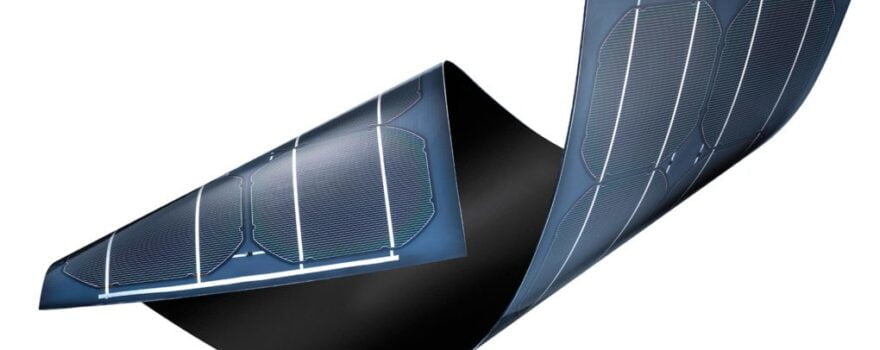
Introduction
Solar technology has evolved significantly over the years, and if you’re an environmentally conscious homeowner or business owner, you’ve likely explored the idea of solar panels. The conventional solar panels installed by most residential solar companies are typically rigid rectangles made of monocrystalline silicon solar cells. However, the world of solar energy is changing, and one exciting development is the rise of flexible, or thin-film, solar panels.
These flexible solar panels are not only changing the way we think about harnessing solar energy but also opening up new possibilities for renewable power generation. In this comprehensive guide, we will delve deep into the world of flexible solar panels, exploring their technology, benefits, drawbacks, and when they might be the perfect fit for your energy needs.

Section I: What Are Flexible Solar Panels?
Flexible solar panels represent a remarkable departure from traditional solar panel technology. While the fundamental principle remains the same – converting sunlight into electricity – it’s the form and composition that set them apart.
Thickness as the Key Differentiator
The fundamental distinction between conventional and flexible solar panels lies in their thickness. Traditional solar panels are made of crystalline silicon solar cells and are known for their rigid structure. In contrast, flexible solar panels are often referred to as “thin-film” panels because their layers of photovoltaic materials are significantly thinner, allowing for flexibility.
To explain the concept further, Matthew Reese, a researcher at the National Renewable Energy Laboratory in Colorado, offers insight. While thin-film panels don’t necessarily have to be flexible, materials tend to become more flexible as they get thinner. Reese adds that some thin-film panels can even be made foldable, showcasing the versatility of this technology.
Variety of Materials
Flexible solar panels are not limited to a single material; instead, they embrace diversity. Over the decades, various technologies have emerged, harnessing different materials to develop thin-film or flexible solar modules. These materials include amorphous silicon, copper indium gallium selenide, cadmium telluride, and gallium arsenide. Emerging technologies like perovskite, organic, and quantum dot photovoltaics show promise for flexible applications in the future.
Intriguingly, some products on the market employ very thin monocrystalline silicon modules that share similarities with traditional rigid rooftop panels. However, they offer a limited degree of flexibility, blending the best of both worlds.
Section II: Benefits of Flexible Solar Panels
Flexible solar panels bring a wealth of advantages to the table, making them an appealing option for a wide range of applications.
Versatile Installation Options
Perhaps the most compelling advantage of flexible solar panels is their ability to be installed on a variety of surfaces and locations. The mantra at the National Renewable Energy Laboratory (NREL) is “PV everywhere.” With flexible, roll-out PV technology, the possibilities are virtually limitless. Picture flexible photovoltaics covering the surface of a car or adorning different sections of a building, including windows. Some solar tiles employ thin-film technology, making them ideal for rooftops.
Lightweight and Portable
Inherently lighter than their rigid counterparts, thinner panels open doors to innovative applications. They can be affixed to drones and airplanes, enabling solar-powered flight. For hikers, flexible solar panels can be incorporated into backpacks, providing a convenient and eco-friendly power source for outdoor adventures.
Moreover, certain thin-film technologies excel in high-heat conditions, making them preferable for use in space missions and specific desert environments. These unique features broaden the scope of where flexible solar panels can be deployed.
Potential for Efficiency Improvement
While thin-film technology may currently lag behind conventional photovoltaic (PV) panels in terms of efficiency and cost-effectiveness, it harbors the potential to surpass them in the future. With ongoing research and development efforts, it’s only a matter of time before thin-film technology becomes more competitive on both fronts.
Flexible panels atop electric vehicles could even extend their driving range, while improvements in efficiency could make thin-film panels an attractive choice for a broader range of applications.
Section III: Downsides of Flexible Solar Panels
Like any technology, flexible solar panels come with their share of challenges and limitations, which must be considered before choosing them for a specific application.
Competition with Conventional Panels
Today, flexible panels face stiff competition from the well-established solar industry, which primarily produces rigid silicon-based rooftop panels at ever-decreasing costs. Some flexible solar panels can already outperform traditional glass panels in terms of efficiency, but this often comes at a significant cost.
For homeowners, the focus of the industry remains on those large glass rectangles that adorn rooftops. “There’s lots of other flavors of PV, and a lot of them aren’t very widespread when it comes to residential use,” explains Lance Wheeler, another NREL researcher.
Efficiency and Cost Trade-offs
The less expensive thin-film technologies tend to be less efficient than conventional rooftop panels, while still costing more than traditional silicon-based modules. Due to their lower efficiencies, current thin-film systems require more roof space to generate the same amount of energy as conventional panels. This factor limits their suitability for a large number of homes.
Durability and Environmental Concerns
Flexible panels can raise durability concerns, especially in harsh environments. Additionally, some materials used in their production, such as cadmium, are highly toxic, raising environmental and safety issues.
Section IV: Pros and Cons of Flexible Solar Panels (Summary)
Let’s summarize the key advantages and disadvantages of flexible solar panels for a quick reference:
Pros:
- Lower carbon footprint due to reduced semiconductor material usage
- Easy and cost-effective installation on a variety of surfaces
- Versatility for portable applications (e.g., RVs, buses, boats)
- Lightweight, making them suitable for numerous applications
Cons:
- Potential inclusion of toxic materials like cadmium
- Lower efficiency compared to traditional panels
- Increased roof space requirements for equivalent energy capacity
- Limited availability in the current market
Section V: When to Consider Installing Flexible Solar Panels
Thin-film solar panels are still limited in availability, but as solar technologies continue to advance, these panels could take off in popularity.
Larger Spaces and Energy Goals
If you have a larger home or business with adequate roof space, thin-film panels may be the most efficient and effective way to achieve your solar goals and save money on energy costs. They may also be an adequate energy solution for portable use on things like RVs, buses, or boat rooftops.
Overcoming Installation Challenges
Flexible solar panels may also be worth considering in instances when regular, rigid panels on a rooftop or ground rack won’t be possible to install for some reason, like a curved facade or vehicle roof. In such a case, using a flexible module is not only likely to be more aesthetically pleasing but will also allow your panel to have multiple lines of sight to the sun, likely producing more power over the course of the day and year.
Future Applications
In the future, flexible panels atop an electric vehicle could be a way to extend your car’s range. As electric vehicles gain prominence, this application may become increasingly relevant.
Finally, if you live in a desert area where heat and sunlight can be extreme, it could be worth exploring whether thin-film technology might actually operate more efficiently for you. Desert environments can pose unique challenges for solar panels, and the adaptability of flexible panels to high-heat conditions could make them an attractive choice.
Section VI: Frequently Asked Questions
To address common inquiries regarding flexible solar panels:
Can You Use Flexible Solar Panels on Roofs?
Flexible panels can be installed just about anywhere, including on rooftops, especially those with uneven surfaces.
How Much Do Flexible Solar Panels Cost?
Flexible panels typically cost more than traditional rigid panels, although prices are expected to continue to come down. A flexible panel may actually be a cheaper option in a situation where a rigid panel would have to be made to a custom size or shape.
What Is the Lifespan of a Flexible Solar Panel?
Again, it varies—although thin-film technologies are typically less durable than conventional rooftop panels, which can operate for decades.
In this section, we’ve addressed some of the most common questions that individuals often have when considering flexible solar panels. Understanding these aspects is crucial for making informed decisions about adopting this innovative solar technology.
Although we currently do not offer flexible solar panels, we invite you to expand your knowledge on solar panel solutions in Singapore. Visit our solar panel comprehensive guide to learn more about the latest advancements and options available. Empower yourself with insights for a brighter and more sustainable future!
Additional Resources:
Solar Panel Installation in Singapore
Solar Panels for Condos
Solar Panel Price
Solar Panel Subsidies
